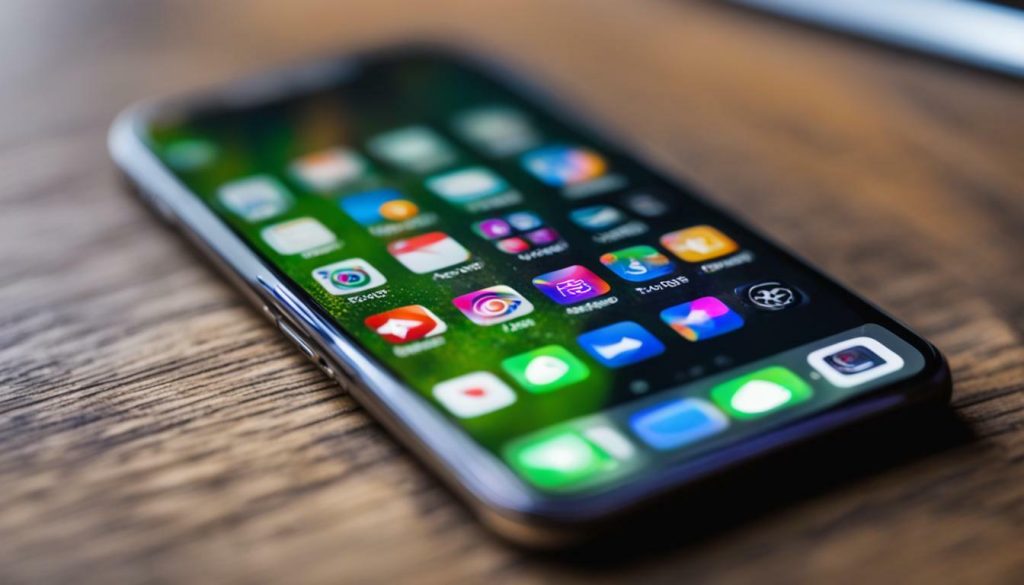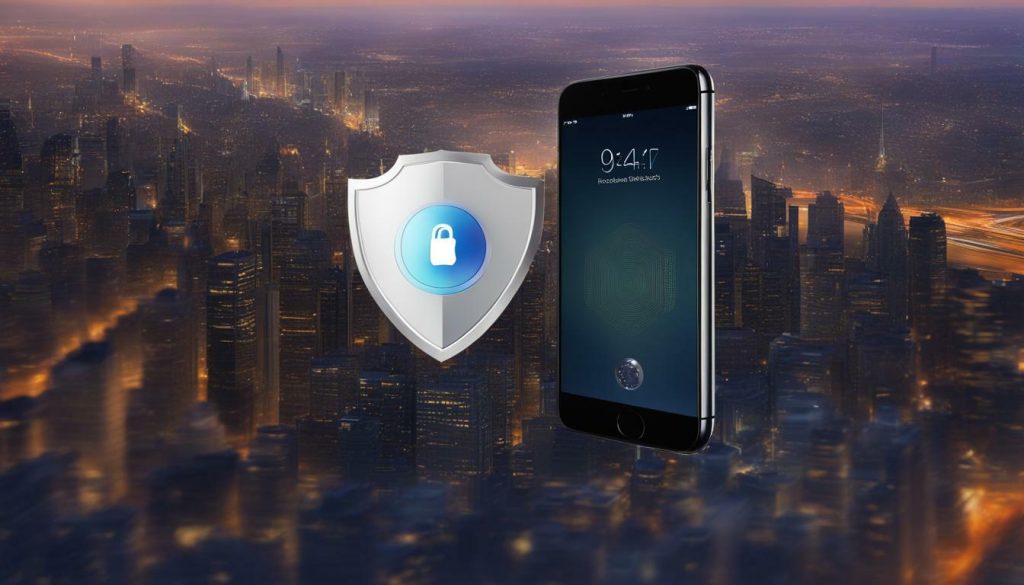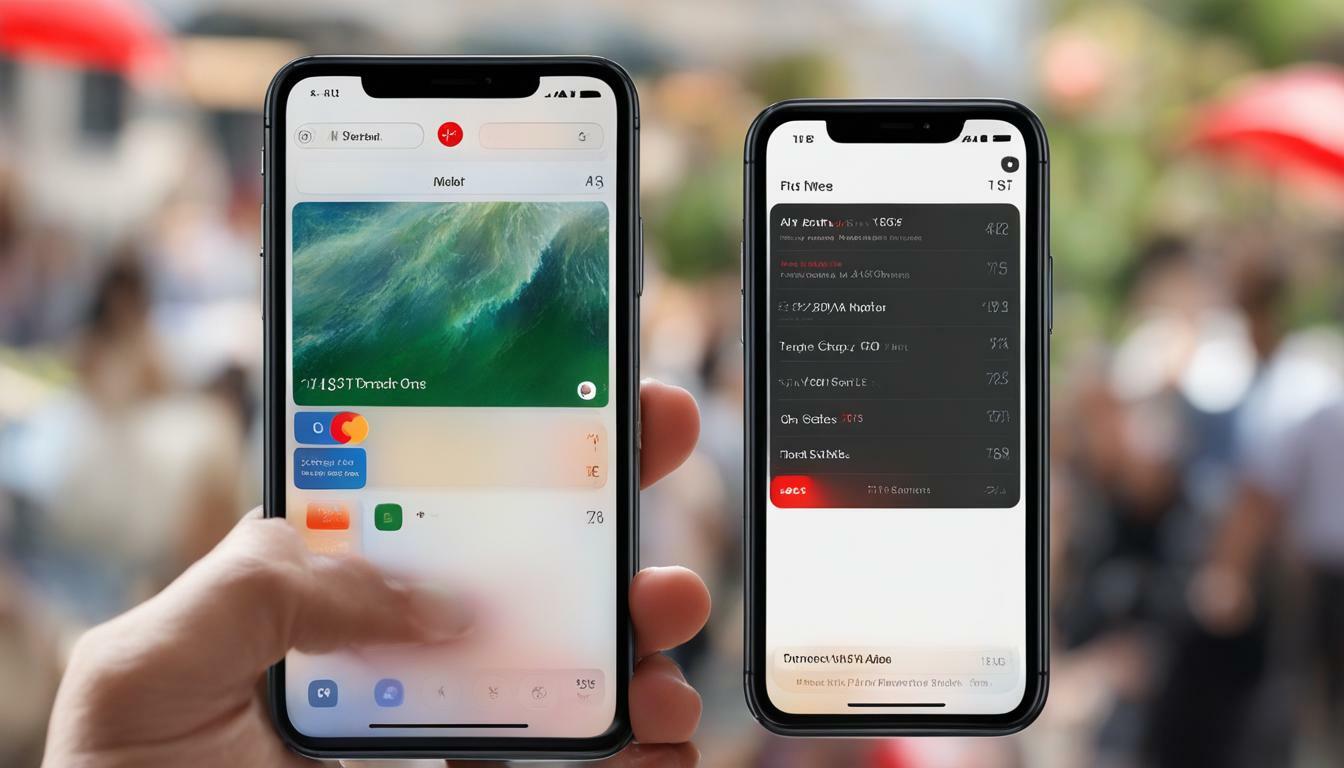Exiting incognito mode on your iPhone is a straightforward process that can be done in just a few simple steps. Whether you’re using Safari or Chrome, we’ve got you covered with easy-to-follow instructions. Say goodbye to private browsing and regain control over your browsing experience.
Key Takeaways:
- Exiting incognito mode on your iPhone is a simple process.
- Follow our step-by-step guide for Safari and Chrome to disable incognito mode.
- Incognito mode is not a guarantee of complete anonymity on the internet.
- Consider additional privacy and security settings on your iPhone to enhance your browsing experience.
- Understand the benefits and limitations of using incognito mode to make informed decisions about your online privacy.
How to Exit Incognito Mode in Safari on iPhone
If you’re using Safari on your iPhone and want to exit incognito mode, follow these instructions to return to regular browsing.
To exit incognito mode in Safari on your iPhone, simply follow these steps:
- Open the Safari app on your iPhone.
- Tap the tabs icon at the bottom of the screen.
- Tap the Private button to display your tab groups.
- Select the regular tabs option, which will have a phone icon next to it.
By following these steps, you will successfully exit incognito mode and return to regular browsing in Safari on your iPhone.
It’s important to note that when you exit incognito mode, your browsing history will no longer be hidden. This means that any websites you visit and any searches you conduct will be visible to anyone who uses your device.
If you want to keep your browsing history private, you should consider using a private browsing mode or regularly deleting your history.
Additional Privacy Settings in Safari
Safari offers additional privacy and security settings that you can utilize to enhance your browsing experience on your iPhone. These settings include:
- Preventing Cross-Site Tracking: Safari limits third-party cookies and data by default, but you can turn this option off to allow cross-site tracking.
- Hiding Your IP Address: Safari automatically protects your IP address from known trackers, but you can turn this option off if you prefer your IP address to be visible.
- Blocking All Cookies: You can turn on this option to prevent websites from adding cookies to your iPhone.
- Fraudulent Website Warning: Safari displays a warning if you’re visiting a suspected phishing website, but you can turn this option off if you don’t want to be warned.
- Privacy Preserving Ad Measurement: This option prevents websites from viewing your personal information to serve you targeted ads.
By exploring and adjusting these privacy settings in Safari, you can further protect your browsing activities on your iPhone.

Remember, while incognito mode can help keep your browsing history private, it does not make you completely anonymous online. If privacy is a top concern for you, consider using a VPN service like ExpressVPN to encrypt your traffic and ensure your online activities remain private.
How to Exit Incognito Mode in Chrome on iPhone
If you’re using Google Chrome on your iPhone and want to exit incognito mode, here’s how you can do it:
Step 1: Open the Chrome app
To begin, locate the Chrome app on your iPhone and tap on it to open the browser.
Step 2: Switch tabs
At the bottom of the screen, you’ll see the tabs icon, which looks like a square with multiple smaller squares inside. Tap on this icon to switch between your open tabs.
Step 3: Find the incognito tab
Swipe right on the screen to view your open incognito tabs. These tabs are separate from your regular browsing tabs and are indicated by a dark theme and a hat and sunglasses icon in the top left corner.
Step 4: Close the incognito tab
Identify the incognito tab you want to exit and tap on the “X” icon in the top right corner of the tab to close it. This will exit incognito mode for that specific tab.
If you have multiple incognito tabs open, repeat the process for each tab until all incognito tabs are closed. Once all incognito tabs are closed, you will have successfully exited incognito mode in Chrome on your iPhone.
| Steps | Description |
|---|---|
| Step 1 | Open the Chrome app |
| Step 2 | Switch tabs |
| Step 3 | Find the incognito tab |
| Step 4 | Close the incognito tab |
By following these simple steps, you can easily exit incognito mode in Chrome on your iPhone and resume regular browsing.
Additional Tips
- If you want to switch between incognito and regular browsing modes, you can tap on the tab switcher icon and select “New Tab” instead of closing the incognito tab.
- To prevent accidentally opening incognito tabs in the future, you can enable the “Close All Incognito Tabs” feature in Chrome settings. This will automatically close all incognito tabs when you exit the app.

“If you’re using Google Chrome on your iPhone and want to exit incognito mode, here’s how you can do it.” – Chrome Support
Understanding the Benefits and Limitations of Incognito Mode
Before we delve into the process of exiting incognito mode, let’s take a moment to understand the benefits and limitations of using this browsing feature on your iPhone.
The Benefits of Incognito Mode
Incognito mode, also known as private browsing or privacy mode, offers several advantages for iPhone users:
- Privacy: When you browse in incognito mode, your browsing history and search results are not saved on your device. This can be particularly useful if you share your iPhone with others and want to keep your browsing activities private.
- Browsing Without Leaving a Trace: Incognito mode prevents websites from storing cookies, which are small pieces of data that track your online activity. This means that advertisers and websites won’t be able to target you with personalized ads based on your browsing history.
- Testing Websites: If you’re a web developer or designer, incognito mode allows you to view websites without the influence of your browsing history or cached data, giving you a fresh perspective on how the site looks and functions.
The Limitations of Incognito Mode
While incognito mode has its benefits, it’s important to be aware of its limitations:
- Not Completely Anonymous: Incognito mode does not make you completely anonymous on the internet. Your internet service provider (ISP) and the websites you visit can still track your IP address and monitor your activity. If you require full anonymity, consider using a virtual private network (VPN).
- Limited Protection: Incognito mode protects your browsing history from being saved on your device, but it does not protect you from other forms of online tracking, such as monitoring your network activity or tracking your location.
- Restricted to Browser: Incognito mode only applies to the browser you are using. It does not extend to other apps or activities on your iPhone, such as messaging or social media apps. For comprehensive privacy protection, explore other privacy settings and features on your device.

In conclusion, incognito mode can be a useful tool for maintaining privacy and preventing your browsing history from being stored. However, it’s important to understand its limitations and take additional steps to protect your online privacy and security on your iPhone.
Exploring Additional Privacy and Security Settings on Your iPhone
In addition to exiting incognito mode, your iPhone offers a range of privacy and security settings that you can customize to protect your browsing activities. These settings are designed to enhance your online privacy and safeguard your personal information. Let’s explore some of the key features and options available:
1. Prevent Cross-Site Tracking
Safari, the default browser on your iPhone, allows you to limit third-party cookies and data by default. By turning on the “Prevent Cross-Site Tracking” setting, you can further protect your privacy by preventing websites from tracking your browsing behavior across different sites. This helps to minimize targeted ads and personalized content based on your browsing history.
2. Hide IP Address
Safari also provides an option to automatically hide your IP address from known trackers. By enabling this setting, you can prevent websites from identifying your location and tracking your online activities. This feature adds an extra layer of privacy and security to your browsing experience.
3. Block All Cookies
If you want to take privacy a step further, you can enable the “Block All Cookies” setting. This prevents websites from adding cookies to your iPhone, enhancing your control over data collection. However, keep in mind that blocking all cookies may affect your browsing experience on certain websites, as some functionality may be reliant on cookies.
4. Fraudulent Website Warning
Safari includes a built-in feature that displays a warning if you’re visiting a suspected phishing website. By keeping this setting enabled, you can protect yourself from potential online threats and scams. It’s an effective way to stay vigilant and ensure that you’re visiting secure and trustworthy websites.

5. Privacy Preserving Ad Measurement
This setting prevents websites from accessing your personal information for targeted advertising purposes. By enabling “Privacy Preserving Ad Measurement,” you can limit the data shared with advertisers while still receiving relevant advertisements. This feature strikes a balance between personalization and privacy.
6. iCloud Private Relay
If you subscribe to iCloud+, you can take advantage of iCloud Private Relay. This feature encrypts your traffic and routes it through two separate internet relays, making it difficult for websites and network providers to track your browsing activity and collect your personal information. iCloud Private Relay provides an extra layer of privacy and security for your online interactions.
Conclusion
By exploring and customizing the privacy and security settings on your iPhone, you can take control of your online privacy and protect your browsing activities. These features, such as preventing cross-site tracking, hiding your IP address, blocking cookies, and enabling fraud website warnings, empower you to browse the web with confidence. Remember to regularly review and adjust these settings to ensure that your privacy remains a priority.
| Setting | Description |
|---|---|
| Prevent Cross-Site Tracking | Limits third-party cookies and data |
| Hide IP Address | Protects your location from trackers |
| Block All Cookies | Prevents websites from adding cookies |
| Fraudulent Website Warning | Alerts you when visiting suspected phishing sites |
| Privacy Preserving Ad Measurement | Protects personal information from advertisers |
| iCloud Private Relay | Encrypts and routes traffic through relays |
Conclusion
In conclusion, being aware of how to exit incognito mode on your iPhone is essential for maintaining privacy and security while browsing the web. Whether you’re using Safari or Chrome, it’s important to know how to disable incognito mode and revert back to regular browsing. By following the step-by-step instructions provided in this guide, you can easily exit incognito mode on your iPhone and ensure that your browsing history and activities are not saved.
In addition to understanding how to exit incognito mode, it’s also important to recognize the benefits and limitations of using incognito mode. While it can help protect your privacy by not saving your browsing history, it’s important to note that incognito mode does not make you completely anonymous on the internet. Your ISP and the government can still monitor your activity and track your IP address. If you truly want to browse anonymously, consider using a VPN service.
Furthermore, exploring additional privacy and security settings on your iPhone can further enhance your browsing experience. Features such as preventing cross-site tracking, blocking cookies, and enabling fraud website warnings can help protect your privacy and secure your browsing activities. By familiarizing yourself with these settings and making the necessary adjustments, you can have more control over your online privacy and security.
Ultimately, maintaining privacy and security while browsing the web is a top priority. By understanding how to exit incognito mode, being aware of the benefits and limitations, and exploring additional privacy and security settings on your iPhone, you can ensure that your browsing activities are protected and your personal information is kept secure.
FAQ
Q: What is incognito mode?
A: Incognito mode, also known as private browsing mode, is a feature available in web browsers that allows users to browse the internet without their browsing history and search results being saved.
Q: How do I turn off incognito mode in Safari on my iPhone?
A: To turn off incognito mode in Safari, open the Safari app, tap the tabs icon at the bottom of the screen, tap the Private button to display your tab groups, and select the regular tabs option.
Q: How do I exit incognito mode in Chrome on my iPhone?
A: To exit incognito mode in Chrome, open the Chrome app, tap the switch tabs button at the bottom, swipe right to see your open Incognito tabs, find the tab you want to close, and tap Close.
Q: What are the benefits of using incognito mode?
A: Incognito mode can help protect your privacy by not saving your browsing history and search results. It can also prevent websites from tracking your activity and showing targeted ads based on your browsing history.
Q: What are the limitations of incognito mode?
A: While incognito mode can hide your browsing history from others using your device, it does not make you completely anonymous online. Your internet service provider (ISP) and the government can still monitor your activity and track your IP address.
Q: What other privacy and security settings can I use on my iPhone?
A: In addition to incognito mode, you can utilize other privacy and security settings on your iPhone, such as preventing cross-site tracking, blocking cookies, enabling fraudulent website warnings, and using a VPN (Virtual Private Network) for enhanced privacy.

Hey there, I’m Wesley! Passionate about all things social platforms, I founded this blog to decode the ever-changing landscape of likes and shares. If you’re looking to up your social game, you’re in the right place. Let’s make your feed something to talk about!




